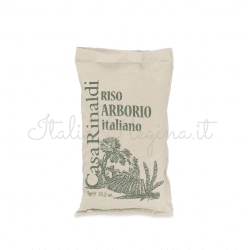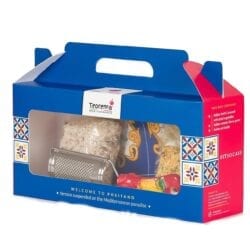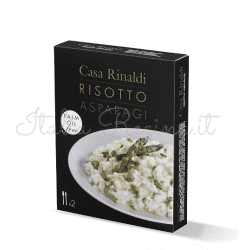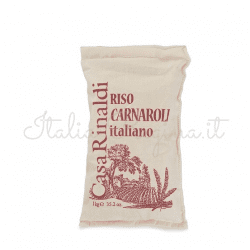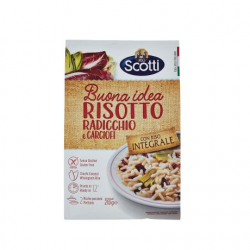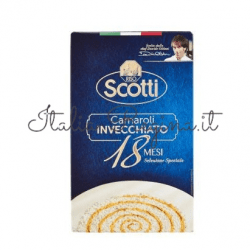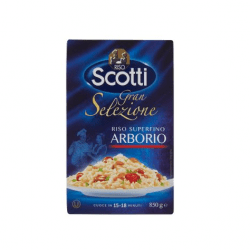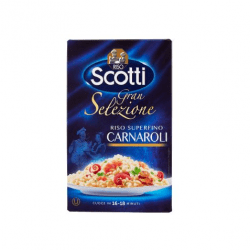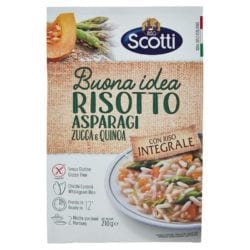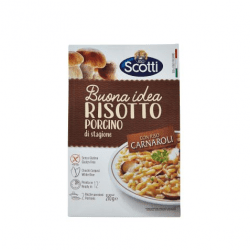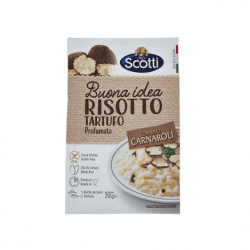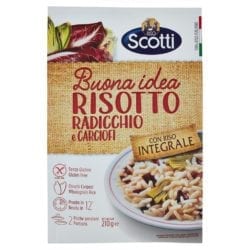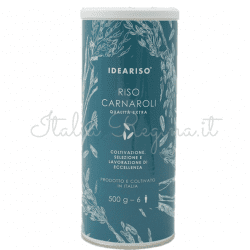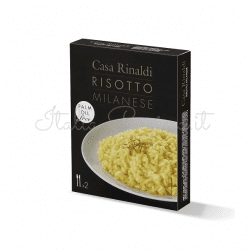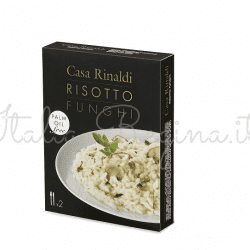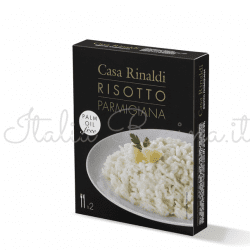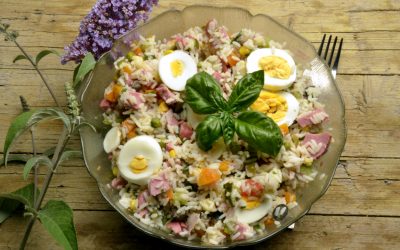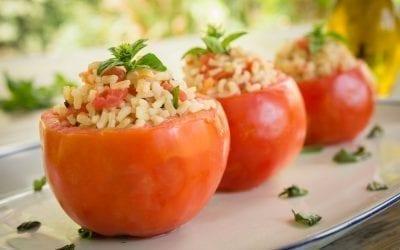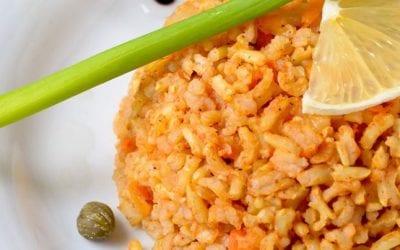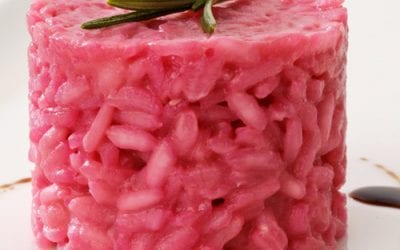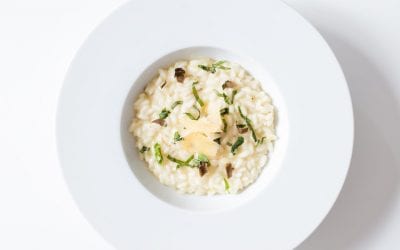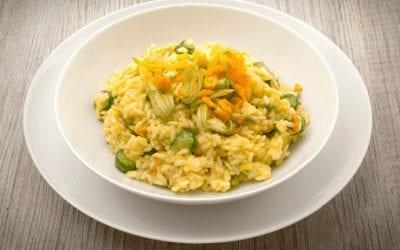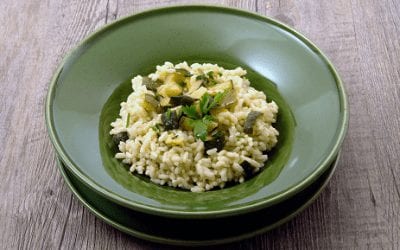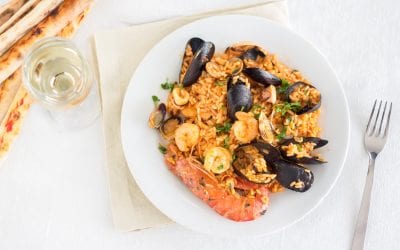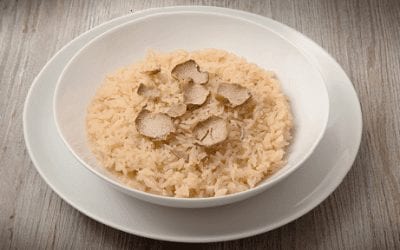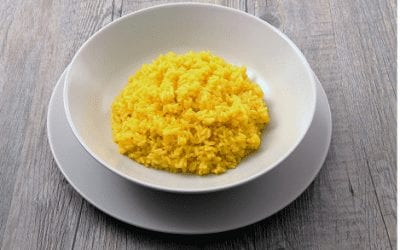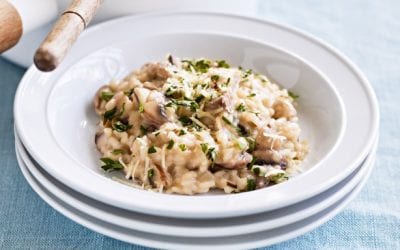Italian Rice
Rice Buy Online to create rice salad or the typical risotto!
In Italia, there are many types of rice. One of these, called “Carnaroli”, is the most used and finest in Italian cuisine. It was obtained in 1945 by a cross between two different types of rice. It doesn’t scratch and doesn’t disintegrate and this is why it is suitable for the preparation of risotto. The Carnaroli is the most prized.
Another type is Arborio rice, it has bigger grain, with a structure that allows a good absorption of seasoning. It is suitable for the preparation of preserved risotto.
There are, also, many ready-made risotto create with different ingredients like asparagus, mushroom, truffle, saffron, parmesan, vegetables.
Buy Italian Rice now!
-

Arborio Rice bag for Risotto 1kg
€8.90 - Sale!

Artisanal Rice and Tools – GiftBox
Original price was: €36.00.€24.90Current price is: €24.90. -

Asparagus Risotto 175 gr – Casa Rinaldi
€2.50 -

Carnaroli Rice bag for risotto 1kg
€9.80 -

Italian Rice – Risotto Dry Parmigiana
€3.50 -

Italian Rice Artichoke and Radicchio
€3.50 -

Italian Rice Carnaroli 18 months aged
€11.00 -

Italian Rice Pumpkin, Asparagus and Quinoa
€3.50 -

Italian Rice Superfine Arborio
€6.50 -

Italian Rice Superfine Carnaroli
€6.20 -

Italian Risotto Asparagus and Pumpkin
€3.40 -

Italian Risotto Dry Milanese with Saffron
€3.40 -

Italian Risotto Dry Seasonal Mushrooms
€3.50 -

Italian Risotto Dry Truffle
€3.50 -

Italian Risotto Radicchio and Artichokes
€3.40 -

Italian Superfino Carnaroli rice
€8.20 -

Milanese Risotto 175 gr
€2.90 -

Mushroom Risotto 175 gr
€3.50 -

Parmigiana Risotto 175g
€2.50
Discover Italian Rice
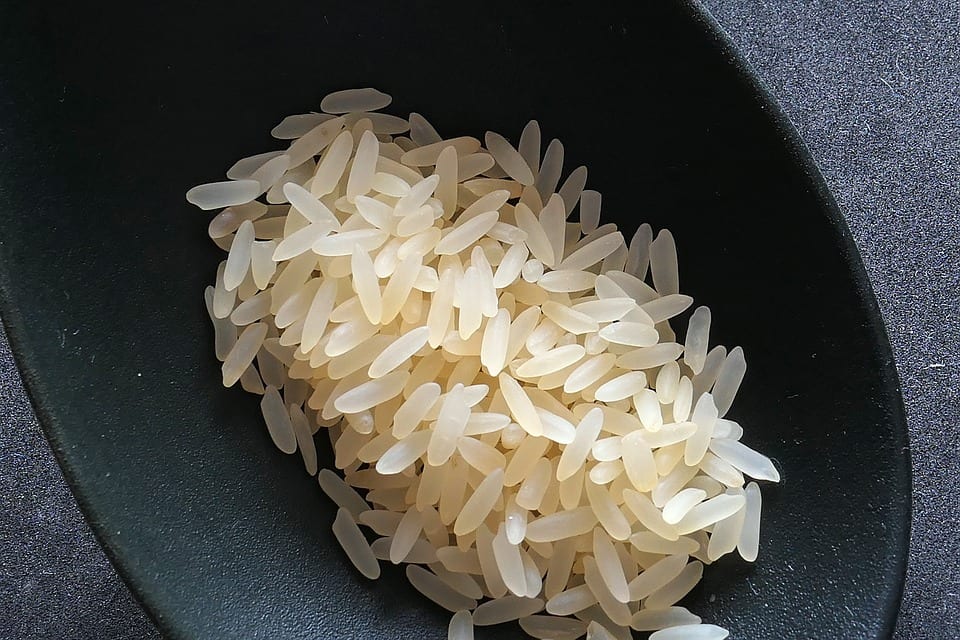 Rice is a cereal originating in the Asian regions and introduced into Europe by the Arabs in the Middle Ages. The two primordial species that can be considered relevant for food purposes are Oryza sativa, of Asian origin, and Oryza glaberrima, of African origin. From the Asian species (Oryza sativa) are derived three subspecies: Japonica, suitable for temperate zones, with a short grain, which is the most widespread in the Italian fields; Indica and Javanica or Tropical Japonica, little known in Italy. Rice is usually sown in the rice fields in spring and it matures in 140-170 days. On the other hand, the combine-harvesting, that is the cutting of the cobs and the separation of the grains, takes place between summer and autumn. First, you have to select the beans and remove the impurities, they pass through the rollers, thus losing the outer coating, called husk, and becoming husked rice. At this point, a new selection is made to extract the immature grains and both the bud and the outer layers are eliminated. At this stage of processing, only whole grains are selected which will then be vacuum-packed and marketed.
Rice is a cereal originating in the Asian regions and introduced into Europe by the Arabs in the Middle Ages. The two primordial species that can be considered relevant for food purposes are Oryza sativa, of Asian origin, and Oryza glaberrima, of African origin. From the Asian species (Oryza sativa) are derived three subspecies: Japonica, suitable for temperate zones, with a short grain, which is the most widespread in the Italian fields; Indica and Javanica or Tropical Japonica, little known in Italy. Rice is usually sown in the rice fields in spring and it matures in 140-170 days. On the other hand, the combine-harvesting, that is the cutting of the cobs and the separation of the grains, takes place between summer and autumn. First, you have to select the beans and remove the impurities, they pass through the rollers, thus losing the outer coating, called husk, and becoming husked rice. At this point, a new selection is made to extract the immature grains and both the bud and the outer layers are eliminated. At this stage of processing, only whole grains are selected which will then be vacuum-packed and marketed.
History of Italian Rice
 The spread of rice to the West, began when in the fourth century BC he landed in Mesopotamia, before arriving in Europe as a food product with Alexander the Great. From Palestine, from the West Bank and Syria, rice cultivation reaches Egypt, probably introduced by Indian populations and subsequently cultivated by the Arabs who spread it in North Africa and Spain. The first information on the rice trade dates back to the first century. A.D. But it was the Greeks who, thanks to their ability to explore unknown lands, made the rice known to the Western world. From the Greeks to the Romans and, later, throughout the Middle Ages and up to the Renaissance period, rice was considered as a spice, as a medicine for various pathologies or for cosmetics. Rice culture developed during the twentieth century in the Po delta. the ancient Roman world, rice wasn’t that of a cereal suitable for human alimentation but rather of a medicinal product which, it was prescribed by doctors to the richest patients to cure body diseases. Rice was known in Italy before the real cultivation began because it was considered a spice and it was sold for therapeutic purposes. Some traces of the presence of rice in Italy are already found in documents of 1390. In 1468 in Lombardy, a region of north Italy, was inaugurated the first paddy field. From Lombardy, the cultivation of rice quickly extended to all the wetlands of the Po Valley, and then in Tuscany and Emilia Romagna.
The spread of rice to the West, began when in the fourth century BC he landed in Mesopotamia, before arriving in Europe as a food product with Alexander the Great. From Palestine, from the West Bank and Syria, rice cultivation reaches Egypt, probably introduced by Indian populations and subsequently cultivated by the Arabs who spread it in North Africa and Spain. The first information on the rice trade dates back to the first century. A.D. But it was the Greeks who, thanks to their ability to explore unknown lands, made the rice known to the Western world. From the Greeks to the Romans and, later, throughout the Middle Ages and up to the Renaissance period, rice was considered as a spice, as a medicine for various pathologies or for cosmetics. Rice culture developed during the twentieth century in the Po delta. the ancient Roman world, rice wasn’t that of a cereal suitable for human alimentation but rather of a medicinal product which, it was prescribed by doctors to the richest patients to cure body diseases. Rice was known in Italy before the real cultivation began because it was considered a spice and it was sold for therapeutic purposes. Some traces of the presence of rice in Italy are already found in documents of 1390. In 1468 in Lombardy, a region of north Italy, was inaugurated the first paddy field. From Lombardy, the cultivation of rice quickly extended to all the wetlands of the Po Valley, and then in Tuscany and Emilia Romagna.
Italian Rice: Properties and Benefits
- it’s easy to digest
- it regulates intestinal flora
- it contains a fundamental amino acid for human beings: lysine and other proteins
- it contains essential fatty acids
- it has a lot of potassium and little sodium, it is perfect for those suffering from arterial hypertension
- it is gluten-free and can therefore also be consumed by those suffering from celiac disease
- it contains vitamins B1, B2, B3
- is an ally of the intestine, connective tissue, and the cardiovascular system
Italian Rice Varieties:
In Italy, there are about 150 varieties and more than 3 thousand in the world, each one characterized by its own organoleptic properties. Among the best known we can find:
- Carnaroli Rice: is the most suitable for the preparation of the typical Italian risotto and is also one of the most prized varieties known in the world. It is characterized by a very long grain, semi-tapered and pearly, which ensures excellent hold and low stickiness during cooking. The Carnaroli, cultivated mainly in the province of Milan, is considered an Italian historical variety. (Cooking time: 16 – 18 min)
- Arborio Rice: takes its name from the municipality of the same name in the province of Vercelli where it has been cultivated since 1946, gaining the status of “historical variety”. It has a long, semi-rounded, slightly squared and pearly grain and is considered one of the best risotto risottos, thanks to the good cooking and creaming resistance. (Cooking time: 17 – 18 min)
- Baldo Rice: it is inserted among the IGP varieties of the Po Delta area. It is characterized by a long, slightly tapered and crystalline grain and is used in the preparation of risotto, especially in the Piedmont area. Together with the Roma rice, it gives its name to the Roma-Baldo group: the two kinds of rice are very similar both in shape and size, differing only in the crystalline grain that characterizes Baldo. (Cooking time: 15 – 17 min)
- Roma Rice: it is characterized by a long, semi-pearled and pearly grain. Rome is often confused with Baldo rice, from which however it differs for the pearly grain. It is a very versatile type of rice in the kitchen, in fact, it can be used to cook risotto, white rice or with sauce or for pies and timbales. (Cooking time: 16 – 17 min)
- Vialone Nano Rice: presents a semi-long, round and pearly grain. Historical variety typical of Veneto (where he obtained the Igp) and of the area surrounding the city of Mantua in Lombardy. Although the grain is of medium size, it is considered as risotto rice, which guarantees excellent cooking resistance, with shorter times than other varieties. (Cooking time: 16 – 17 min)
- Andrea Rice: it is a typical variety of Piedmont that takes its name from the homonymous abbey of the city of Vercelli. It comes with a long, semi-pearled and pearly grain; thanks to its particular characteristics it has been included in the DOP Riso of Baraggia Biellese and Vercellese. The grain, although slightly smaller, guarantees an excellent cooking resistance, both for soups and soups and risottos. Riso S. Andrea is used to make one of the typical local dishes: panissa. (Cooking time: 14 – 16 min)
- Padano Rice: characterized by a medium grain, semi-round, pearly and a low level of amylose, which does not guarantee an optimal hold during cooking, it is perfect for soups, soups, minestrone and oven preparations, such as arancini or timballi. (Cooking time: 15 min)
- Ribe Rice: it has a long, tapered grain, with a little pearl that in cooking loses starch, resulting slightly sticky. For this reason in the kitchen is considered a versatile rice for different preparations such as rice salads, fillings, side dishes or timbales, supplì, and arancini, is less suitable for risotto, if not for that cooked medium. (Cooking time: 15 – 17 min)
- Rosa Marchetti Rice: it is a historic Italian variety that was discovered in 1963 in Arborio, in the area bordering the city of Vercelli, by the farmer Domenico Marchetti who gave him the name in honor of his wife. Rice presents itself with a semi-long grain, tapered and crystalline seeds. It is suitable not only for soups and soups but also for risottos, timbales and as a base for sweets and cakes. (Cooking time: 16 – 17 min)
Recipes Italian Rice
Rice Salad
Rice Salad is a unique dish typical of the summer season: perfect to prepare in the morning to find it ready to return from the beach. It is a fresh, light and personalized recipe with different ingredients according to one's taste, as long as they are...
Rice: excellence and Italian treasure
Rice, characterized by a thousand-year history and from distant origins, with the years has managed to make its way into the Italian culinary tradition becoming a cornerstone of our diet, bringing Italian production worldwide THE CULTIVATION OF RICE:...
Mozzarella Stuffed Tomatoes
Mozzarella stuffed tomatoes are a unique dish made with tomatoes that are stuffed with a tasty filling of rice, basil, and parsley with a heart of Italian streamlined mozzarella to make them even more appetizing. they are a really simple but effective recipe...
Pink Rice
Pink Rice it's a quick and easy recipe to enjoy rice in an innovative and fun way. Brown rice, carrots, orange, scamorza, tuna and a few drops of Balsamic Vinegar: a few simple ingredients for an excellent result! Ingredients: 350 gr brown rice 1...
Risotto with Beetroot Juice, essence of Rosemary, and Balsamic Vinegar
Risotto with Beetroot Juice is a recipe that combines sweetness, color, and acidity. The beetroot, known for its sweetness and its cheerful and intense color, is the star of this tasty and creamy first course. Different for both color and taste from the classic...
Truffle Risotto
Truffle Risotto Ingredients: 320 gr of Carnaroli rice 10 gr of White truffle 750 gr of Meat Broth 50 gr of Parmigiano Reggiano cheese 50 gr of Butter Extra-virgin olive oil Black pepper and Salt Truffle Risotto...
Zucchini flowers Risotto
Zucchini flowers Risotto is a light but very tasty first course, which is ideal during the spring and summer period.
Zucchini flowers Risotto
Zucchini flowers Risotto is a light but very tasty dish that enhances the delicate taste of zucchini flowers, ideal during the spring and summer period. To give a touch of extra color add saffron to the risotto. Ingredients: 900ml of...
Zucchini Risotto
Zucchini Risotto is a simple but tasty and genuine recipe. It's perfect for enjoying on a fresh spring day, and blended with creamy Pecorino cheese creates a perfect blend! Ingredients: 320 g Carnaroli Rice 350 g of Zucchini 1 l of...
Seafood Risotto
Seafood Risotto is a fresh and genuine first course that enhances the quality of the fish chosen for the recipe. You can use either fresh or frozen fish, obviously, with fresh fish, the result will be even more amazing! Ingredients: 320 gr...
Risotto with Truffle
Risotto with Truffle is a delicious dish that conquers the most demanding palates with its unmistakable and amazing scent. Truffle in the kitchen is considered a real wealth, especially white truffle. No elaborate preparations, few ingredients and a carefully selected...
Milanese Risotto
Milanese Risotto (or Saffron Risotto) is a north Italian rice dish cooked in a broth to a creamy consistency. The broth can be derived from meat, fish, or vegetable. Many types of risotto contain butter, wine, and onion. It is one of the most common ways of cooking...
Rice Arancine
Rice Arancine are stuffed rice balls, which are coated with breadcrumbs, and fried. Arancini are usually filled with ragù (meat and tomato sauce), mozzarella, and peas. There are a number of local variants that differ in fillings and shape. The name derives from their...
Porcini Mushrooms Risotto
Porcini Mushrooms Risotto presses all the right buttons, with intense porcini mushrooms and plump arborio rice. Risotto is a north Italian rice dish cooked in a broth to a creamy consistency. The broth can be derived from meat, fish, or vegetable. Many types of...

